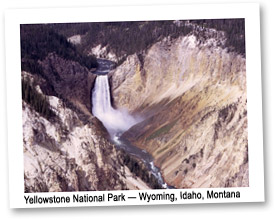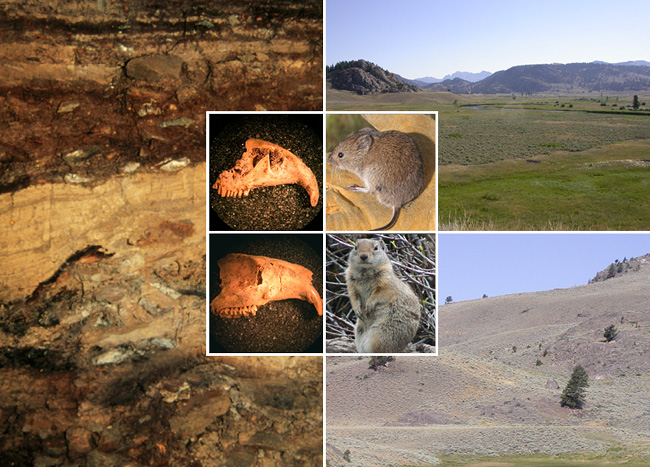

Yellowstone National Park — Wyoming, Idaho, Montana
by Sarah Tulga and David Smith
Throughout the 28,000 square miles of Yellowstone National Park, the majority of which is located in northwest Wyoming, visitors can see and experience diverse animals, vegetation, geology and natural history. While the park is best known for its more than 10,000 thermal features and active geysers, Yellowstone's stratigraphic record spans the Precambrian Era to the Holocene Epoch — the oldest rocks being 2.7 billion years old — and many of these rocks are fossiliferous.
The first fossils to be found were fossil plants reported by paleobotanist Charles Leo Lesquereaux in 1872, the very year that Yellowstone became the world's first national park. Since that time, fossils have been found in rocks of Cambrian, Ordovician, Devonian, Mississippian, Permian, Jurassic, Cretaceous, Eocene, Pleistocene, and Holocene age within the park:1
Cambrian: trilobites, brachiopods, hyolithids, archaeocyathids, stromatolites, invertebrate traces, fossil fragments
Ordovician: ostracodes, brachiopods, bryozoans, crinoids
Devonian: brachiopods, corals, gastropods, stromatoporoids
Mississippian: brachiopods, corals, crinoids, fossil fragments
Permian: fish bones, sharks
Jurassic: brachiopods, bivalves, ammonites, belemnites, gastropods, wood, fragmentary dinosaur bones
Cretaceous: bivalves, ammonites, cephalopods, gastropods, ferns, deciduous leaves, spores, pollen, palynomorphs, dinoflagellates, invertebrate burrows, dinosaur eggshell, fish (scales, teeth, vertebrae), turtle bones, unidentified vertebrate bones
Eocene: horsetails, ferns, conifers, angiosperms, leaves, unclassified plants and plant debris, petrified wood
Pleistocene: insects, moss mats, pollen, diatoms, horses
Holocene: plants, mollusks, fish, amphibians, shrews, rodents, rabbits, bats, canids, felids, mustelids, bears, deer, elk, bison, reptiles, birds, packrat middens
UCMP involvement
The two most significant and most studied fossil resources within the park are its impressive petrified forests and the subfossil material collected in Lamar Cave. Specimens from both are represented in the UCMP database.
The petrified forests
Petrified forests are not all that unusual, but what makes Yellowstone's so unique is that there are multiple layers of buried forests — up to 50 or more in some places. These were buried in volcanic tuffs and debris flows during the late Eocene. The forests are important because both wood and leaves are found together, many tree trunks are upright as they were in life, everything from leaves and needles to cones and seeds are preserved, larges areas of these forests are exposed, and they provide valuable climate data for the Eocene.
Paleobotanist Charles Brian Read (1907-1979) collected and described specimens of coniferous trees from some of the park's petrified forests after completing his graduate work at at UC Berkeley (1927-1930). UCMP's Ralph Chaney apparently encouraged Read to pursue paleobotany. During the summer of 1930, Read conducted a study of the Tertiary plants of Yellowstone National Park2 with funding from the Carnegie Institution of Washington, which Chaney was affiliated with at that time. The specimens Read collected — which represent Sequoia magnifica (Read described it as being very similar to today's Sequoia sempervirens), Pinus baumani, Pinus fallax, and Cupressinoxylon lamarense (i.e., a coniferous tree having an internal structure similar to that of present-day cypress) — were reposited at UCMP and are in the database. After his summer at Yellowstone, Read accepted a position with the USGS (August 1930) and remained with them for the rest of his career.
Lamar Cave
Perhaps equal in importance to the petrified forests are the subfossil materials from Lamar Cave, collected and studied by Stanford University professor of Biology Elizabeth Hadly when she was a student. The material represents 36 mammal species — as well as a number of fish, reptiles, amphibians, and birds — from the late Holocene. Multiple layers of undisturbed sediments containing the accumulated remains of animals dating back some 3000 years enabled Hadly to make inferences about the area's biodiversity and ecosystem development through time.
Hadly excavated a single pit of fossils, distributed through 16 stratigraphic levels, in Lamar Cave between 1987 and 1993. She did her Masters thesis at Northern Arizona University on the cave's mammals and continued the work for her Ph.D. dissertation at UC Berkeley.
Hadly found that the Lamar Cave fossils demonstrated an ecosystem transition. The lowest and oldest layers contained bones from the prairie vole (Microtus ochrogaster), a mammal no longer found in Yellowstone. While vole fossils decreased, those of ground squirrels (Spermophilus sp.) increased. The prairie vole tends to live in tall-grass habitats and ground squirrels prefer more open grasslands, like those that exist in Yellowstone today. This change suggests — and is supported by pollen studies in a nearby pond — that the habitat transitioned from tall-grass to more open grasslands during a prolonged period of aridity. Radiocarbon dates indicate that the transition took place over a period of 500 to 600 years. These types of transitions have also been documented in the modern record on the High Plains and the central Great Plains. In addition to this ecosystem-focused research, fossils from Lamar Cave have been utilized to evaluate climate effects on mammal populations such as pocket gophers, patterns of species diversity, and genetic diversity in montane voles and northern pocket gophers over time.

Yellowstone fossils have had a significant impact on diversity, ecology, and climate-change research and remain valuable resources for paleontologists.
In the collections
UCMP's database includes 24 tangential, longitudinal, and/or transverse sections of the four types of conifer wood collected by Read in Yellowstone's petrified forests.
A search of the UCMP database returns 8509 results for Lamar Cave. Eighteen hundred of those are amphibian (salamander) specimens; the remaining 6709 are all mammal specimens.3 About 30 genera are represented, with the most common mammals being voles (more than 27% of the total), ground squirrels (~18%), wood rats (~14%), deer mice (more than 12%), and pocket gophers (~9.5%). The fish, reptile, and bird specimens collected by Hadly may have been retained by the National Park Service for its own collections. While the fossils from Lamar Cave are curated and databased in the UCMP collection, they are currently housed at Stanford University, where they continue to be studied.
Note: Collection of fossil material is illegal unless done under a permit from the National Park Service. If you think you have found a fossil on National Park lands, please contact a park representative.
More information
The full text of some of the journal articles may not be accessible to everyone.
Yellowstone Paleontological Survey (pdf or web-based)
About Yellowstone's petrified forests
Yellowstone National Park website
Yellowstone National Park on Facebook
Barnosky, E.H. 1994. Ecosystem dynamics through the past 2000 years as revealed by fossil mammals from Lamar Cave in Yellowstone National Park, USA. Historical Biology 8(1-4):71-90. doi:10.1080/10292389409380472
![]()
Barnosky, A.D., E.A. Hadly, and C.J. Bell. 2003. Mammalian response to global warming on varied temporal scales. Journal of Mammalogy 84(2):354-368.
![]()
Barnosky, A.D., C.J. Bell, S.D. Emslie, H.T. Goodwin, J.I. Mead, C.A. Repenning, E. Scott, and A.B. Shabel. 2004. Exceptional record of mid-Pleistocene vertebrates helps differentiate climatic from anthropogenic ecosystem perturbations. Proceedings of the National Academy of Sciences of the United States of America 101(25):9297-9302. doi:10.1073/pnas.0402592101
![]()
Hadly, E.A. 1996. Influence of late-Holocene climate on northern Rocky Mountain mammals. Quaternary Research 46:298-310. doi:10.1006/qres.1996.0068
![]()
Hadly, E. 1997. Evolutionary and ecological response of pocket gophers (Thomomys talpoides) to late-Holocene climatic change. Biological Journal of the Linnean Society 60(2):277-296. doi:10.1006/bijl.1996.0094
![]()
Hadly, E.A. 1999. Fidelity of terrestrial vertebrate fossils to a modern ecosystem. Palaeogeography, Palaeoclimatology, Palaeoecology 149(1-4):389-409. doi:10.1016/S0031-0182(98)00214-4
![]()
Hadly, E.A., and B.A. Maurer. 2001. Spatial and temporal patterns of species diversity in montane mammal communities of western North America. Evolutionary Ecology Research 3(4):477-486.
![]()
Hadly, E.A., U. Ramakrishnan, Y.L. Chan, M. van Tuinen, K. O'Keefe, P.A. Spaeth, and C.J. Conroy. 2004. Genetic response to climatic change: Insights from ancient DNA and phylochronology. PLoS Biology 2(10):e290. doi:10.1371/journal.pbio.0020290
![]()
Lesquereux, L. 1872. An enumeration with descriptions of some Tertiary fossil plants from specimens procured in the explorations of Dr. F.V. Hayden in 1870. U.S. Geological and Geographical Survey of the Territories (Hayden) Annual Report 5, Suppl.:283-318.
1 Based on a paleontological inventory taken by the National Park Service (2012 data). Fossil inventories for all the NPS fossil parks can be found on The Paleontology Portal's Fossils in the National Parks" module.
2 Read, C.B. 1933. Fossil floras of Yellowstone National Park, Part I. Coniferous woods of Lamar River flora. Carnegie Institute of Washington Publication 416:1-19.
3 In Hadly's 1995 Ph.D. dissertation, she reported that 10,597 mammal specimens had been identified and recovered. Perhaps the National Park Service retained some of the mammal specimens for its own collections (in addition to the fish, reptiles, and birds).
NPS photo of Yellowstone's Lower Falls by A. Mebane.